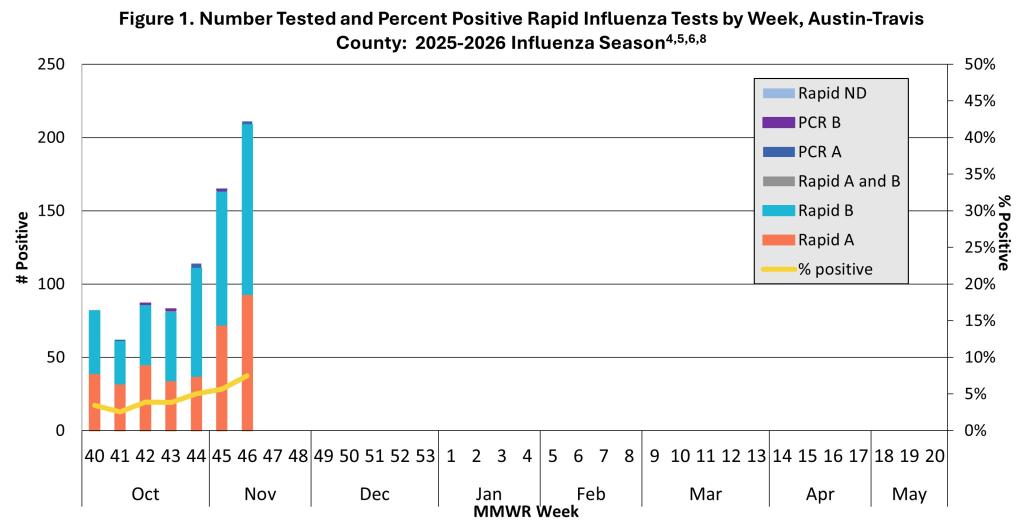Flu Trends | Flu Symptoms | Flu Treatment | Flu Vaccine | Where To Get Vaccinated | Flu Prevention
Flu in Austin (Influenza)
Influenza, known as “the flu,” is a contagious respiratory illness caused by a virus. Most people will have mild illness, but some cases can result in hospitalization or even death.
Flu Trends in Austin-Travis County

ILI stands for influenza-like illness, which is defined as a fever ≥100° F with a cough and/or sore throat.
Austin-Travis County influenza surveillance does not capture all cases of influenza or influenza-like illness. Reporting of seasonal influenza is voluntary. These data should be used for trending purposes over time and for identifying types/strains of influenza that are occurring in the Austin area rather than for estimating the total number of cases.
Flu Symptoms.png)
You may be contagious from one day before and up to seven days after becoming sick. Influenza may present the following symptoms:
- Sudden onset
- Fever or chills
- Cough, sore throat
- Runny or congested nose
- Muscle or body aches
- Headache
- Severe fatigue
What To Do If You're Sick.png)
Use over-the-counter medications like ibuprofen or cough syrup to relieve symptoms. Rest in bed and drink lots of fluids. If you contact your doctor within 48 hours of symptom onset, you may be able to take an antiviral drug, which will reduce the severity of symptoms and length of the illness.
Seek immediate medical attention if a child has trouble breathing, has a bluish skin color, or is not waking up or interacting. Seek immediate medical attention if an adult has difficulty breathing, shortness of breath, sudden dizziness or confusion, is severely or persistently vomiting, or improves but then gets worse.
The Centers for Disease Control and Prevention (CDC) recommends prompt treatment for people who have flu or suspected flu and who are at higher risk of serious flu complications.
- Flu Vaccination
-
The CDC recommends that everyone six months of age and older receive a flu vaccine annually to reduce the risk of influenza and potentially serious complications. High-risk individuals include:
- Adults over 65
- Pregnant women
- People with chronic medical conditions
- Health care workers
- Individuals who live with and/or care for high-risk individuals
- Where to Get Vaccinated
-
Flu shots are available at Shots for Tots/Big Shots clinics for children who are uninsured or Medicaid recipients, and for uninsured adults. The cost of the flu vaccine is $25 for adults, $10 for children, and free for children with Medicaid. To schedule an appointment, please call 512-972-5520.
For those who are insured, visit Vaccines.gov to find a location with flu vaccine near you.
Download a flyer on flu vaccines in English | español | Tiếng Việt | 中文 (简体).
- Additional Flu Prevention
-
In addition to the flu vaccine, there are certain preventative measures an individual can take to prevent the flu:
- Wash your hands often with soap and water, or use an alcohol-based hand sanitizer if soap is unavailable
- Cough and sneeze into your sleeve or into a tissue
- Avoid touching your nose, mouth, and eyes
- Avoid others who are sick
- Stay home if you are sick
Austin-Travis County Influenza Surveillance
The official flu season began on Sept. 28, 2025. The information below contains data through Nov. 15, 2025:
- Weekly Report
-
- Flu activity in Texas is minimal. The Centers for Disease Control and Prevention (CDC) reports that seasonal flu activity remains low nationally but is increasing.
- There have been no adult influenza-associated deaths reported this season in Travis County.
- No influenza-associated outbreaks in schools or long-term care facilities have been reported this season in Travis County.


Austin-Travis County influenza surveillance does not capture all cases of influenza or influenza-like illness. Reporting of seasonal influenza is voluntary. These data should be used for trending purposes over time and for identifying types/strains of influenza that are occurring in the Austin area rather than for estimating the total number of cases.
Additional Resources
For more information about respiratory illness at the state level, please visit: Texas Respiratory Virus Surveillance Report | Texas DSHS
For more information about flu at the national level, please visit: FluView | FluView | CDC
For more information about respiratory illnesses, please visit: About Respiratory Illnesses | Respiratory Illnesses | CDC and 2025-2026 Respiratory Disease Season Outlook | CFA: Qualitative Assessments | CDC





.png)
.png)
